Sample Assignment on Microeconomics
VerifiedAdded on 2021/06/18
|17
|1640
|32
AI Summary
Contribute Materials
Your contribution can guide someone’s learning journey. Share your
documents today.
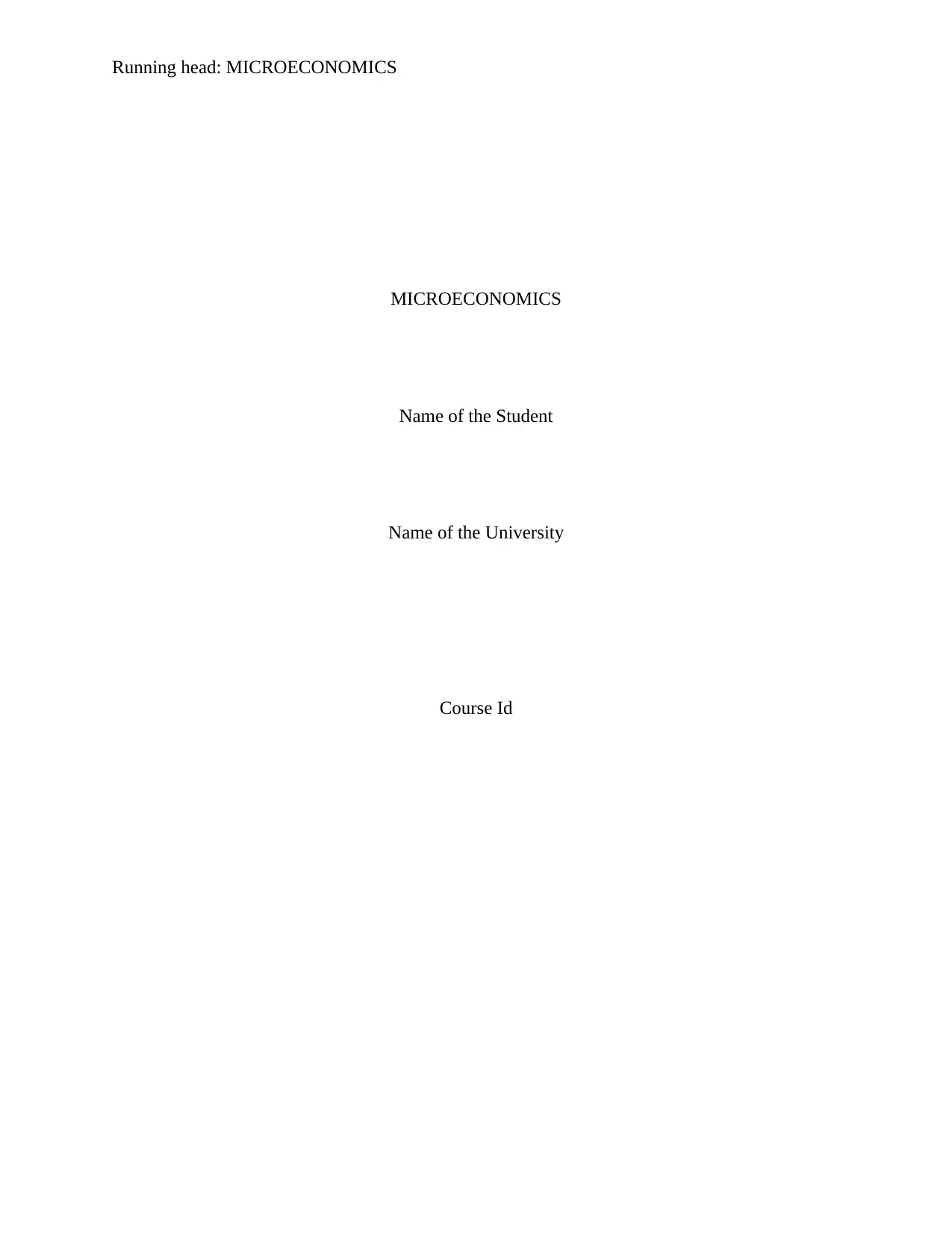
Running head: MICROECONOMICS
MICROECONOMICS
Name of the Student
Name of the University
Course Id
MICROECONOMICS
Name of the Student
Name of the University
Course Id
Secure Best Marks with AI Grader
Need help grading? Try our AI Grader for instant feedback on your assignments.
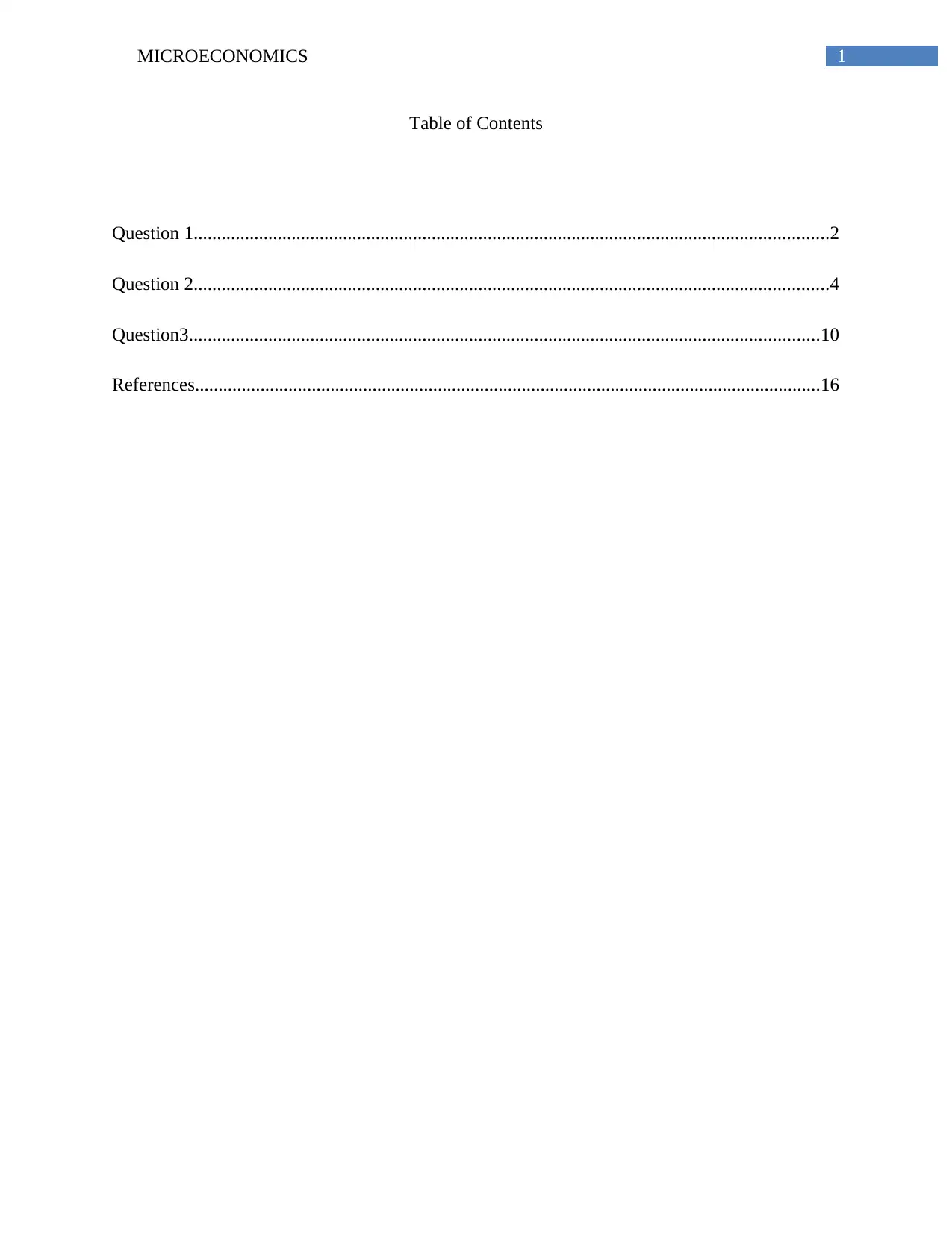
1MICROECONOMICS
Table of Contents
Question 1........................................................................................................................................2
Question 2........................................................................................................................................4
Question3.......................................................................................................................................10
References......................................................................................................................................16
Table of Contents
Question 1........................................................................................................................................2
Question 2........................................................................................................................................4
Question3.......................................................................................................................................10
References......................................................................................................................................16
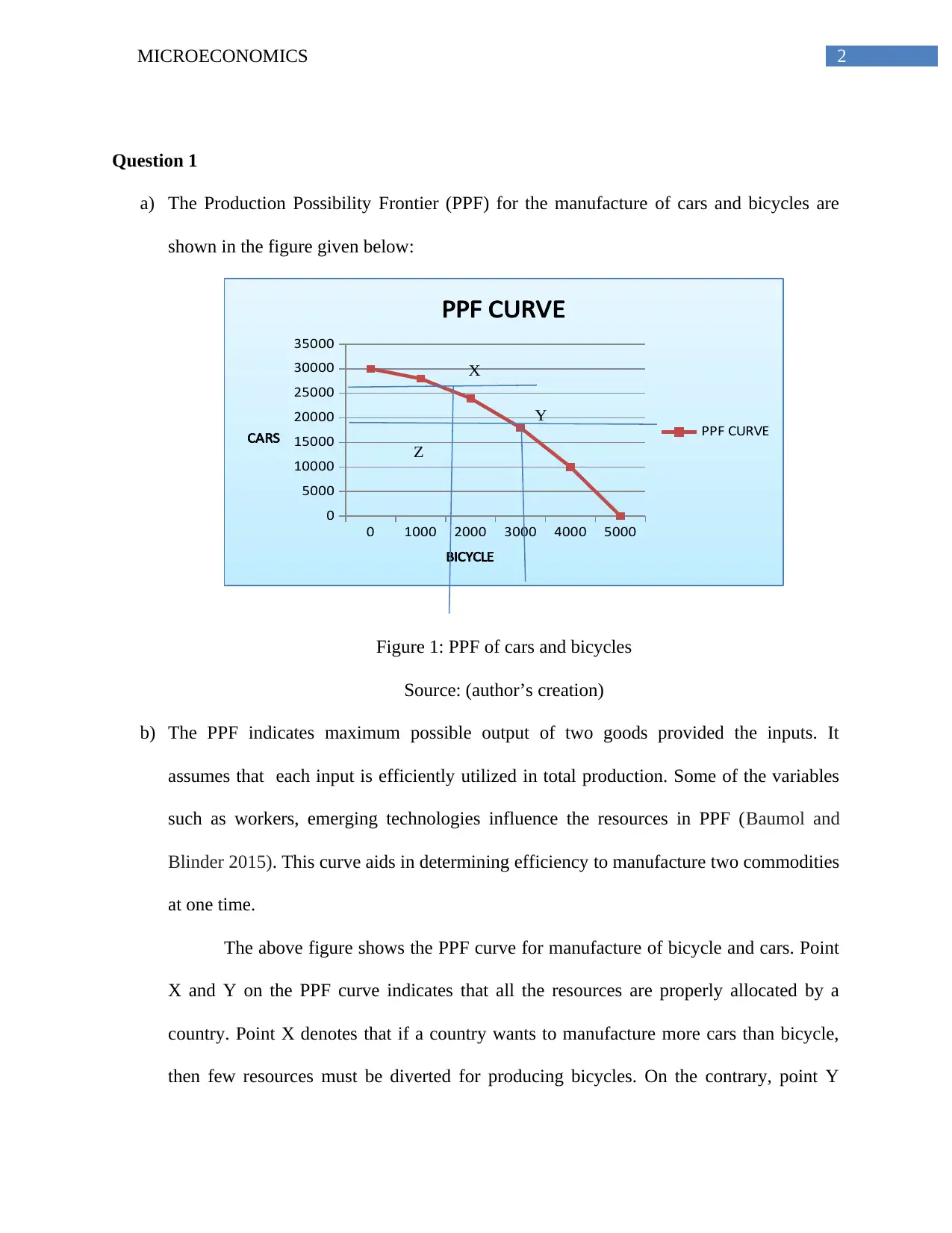
2MICROECONOMICS
Question 1
a) The Production Possibility Frontier (PPF) for the manufacture of cars and bicycles are
shown in the figure given below:
0 1000 2000 3000 4000 5000
0
5000
10000
15000
20000
25000
30000
35000
PPF CURVE
PPF CURVE
BICYCLE
CARS
X
Y
Z
Figure 1: PPF of cars and bicycles
Source: (author’s creation)
b) The PPF indicates maximum possible output of two goods provided the inputs. It
assumes that each input is efficiently utilized in total production. Some of the variables
such as workers, emerging technologies influence the resources in PPF (Baumol and
Blinder 2015). This curve aids in determining efficiency to manufacture two commodities
at one time.
The above figure shows the PPF curve for manufacture of bicycle and cars. Point
X and Y on the PPF curve indicates that all the resources are properly allocated by a
country. Point X denotes that if a country wants to manufacture more cars than bicycle,
then few resources must be diverted for producing bicycles. On the contrary, point Y
Question 1
a) The Production Possibility Frontier (PPF) for the manufacture of cars and bicycles are
shown in the figure given below:
0 1000 2000 3000 4000 5000
0
5000
10000
15000
20000
25000
30000
35000
PPF CURVE
PPF CURVE
BICYCLE
CARS
X
Y
Z
Figure 1: PPF of cars and bicycles
Source: (author’s creation)
b) The PPF indicates maximum possible output of two goods provided the inputs. It
assumes that each input is efficiently utilized in total production. Some of the variables
such as workers, emerging technologies influence the resources in PPF (Baumol and
Blinder 2015). This curve aids in determining efficiency to manufacture two commodities
at one time.
The above figure shows the PPF curve for manufacture of bicycle and cars. Point
X and Y on the PPF curve indicates that all the resources are properly allocated by a
country. Point X denotes that if a country wants to manufacture more cars than bicycle,
then few resources must be diverted for producing bicycles. On the contrary, point Y
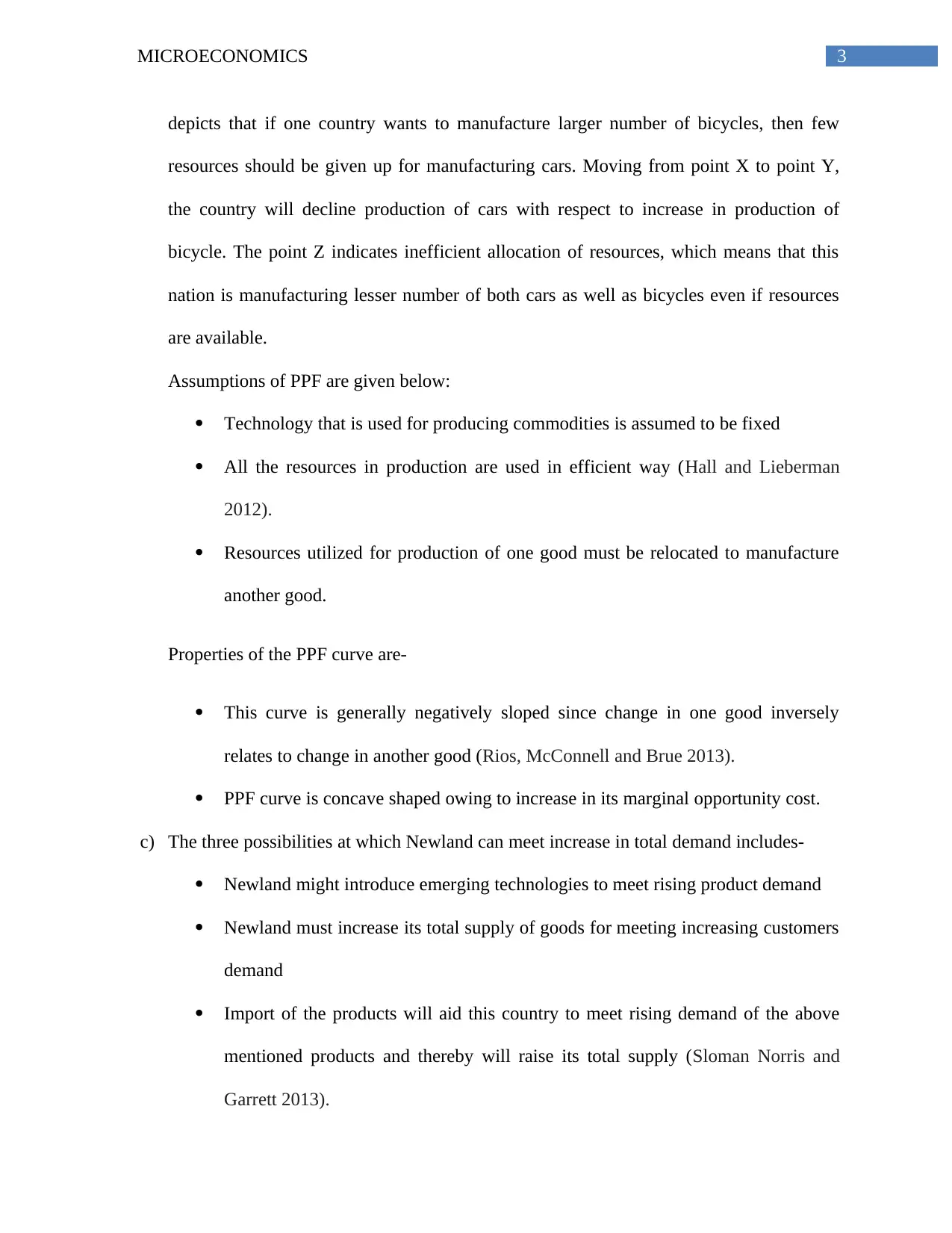
3MICROECONOMICS
depicts that if one country wants to manufacture larger number of bicycles, then few
resources should be given up for manufacturing cars. Moving from point X to point Y,
the country will decline production of cars with respect to increase in production of
bicycle. The point Z indicates inefficient allocation of resources, which means that this
nation is manufacturing lesser number of both cars as well as bicycles even if resources
are available.
Assumptions of PPF are given below:
Technology that is used for producing commodities is assumed to be fixed
All the resources in production are used in efficient way (Hall and Lieberman
2012).
Resources utilized for production of one good must be relocated to manufacture
another good.
Properties of the PPF curve are-
This curve is generally negatively sloped since change in one good inversely
relates to change in another good (Rios, McConnell and Brue 2013).
PPF curve is concave shaped owing to increase in its marginal opportunity cost.
c) The three possibilities at which Newland can meet increase in total demand includes-
Newland might introduce emerging technologies to meet rising product demand
Newland must increase its total supply of goods for meeting increasing customers
demand
Import of the products will aid this country to meet rising demand of the above
mentioned products and thereby will raise its total supply (Sloman Norris and
Garrett 2013).
depicts that if one country wants to manufacture larger number of bicycles, then few
resources should be given up for manufacturing cars. Moving from point X to point Y,
the country will decline production of cars with respect to increase in production of
bicycle. The point Z indicates inefficient allocation of resources, which means that this
nation is manufacturing lesser number of both cars as well as bicycles even if resources
are available.
Assumptions of PPF are given below:
Technology that is used for producing commodities is assumed to be fixed
All the resources in production are used in efficient way (Hall and Lieberman
2012).
Resources utilized for production of one good must be relocated to manufacture
another good.
Properties of the PPF curve are-
This curve is generally negatively sloped since change in one good inversely
relates to change in another good (Rios, McConnell and Brue 2013).
PPF curve is concave shaped owing to increase in its marginal opportunity cost.
c) The three possibilities at which Newland can meet increase in total demand includes-
Newland might introduce emerging technologies to meet rising product demand
Newland must increase its total supply of goods for meeting increasing customers
demand
Import of the products will aid this country to meet rising demand of the above
mentioned products and thereby will raise its total supply (Sloman Norris and
Garrett 2013).
Secure Best Marks with AI Grader
Need help grading? Try our AI Grader for instant feedback on your assignments.
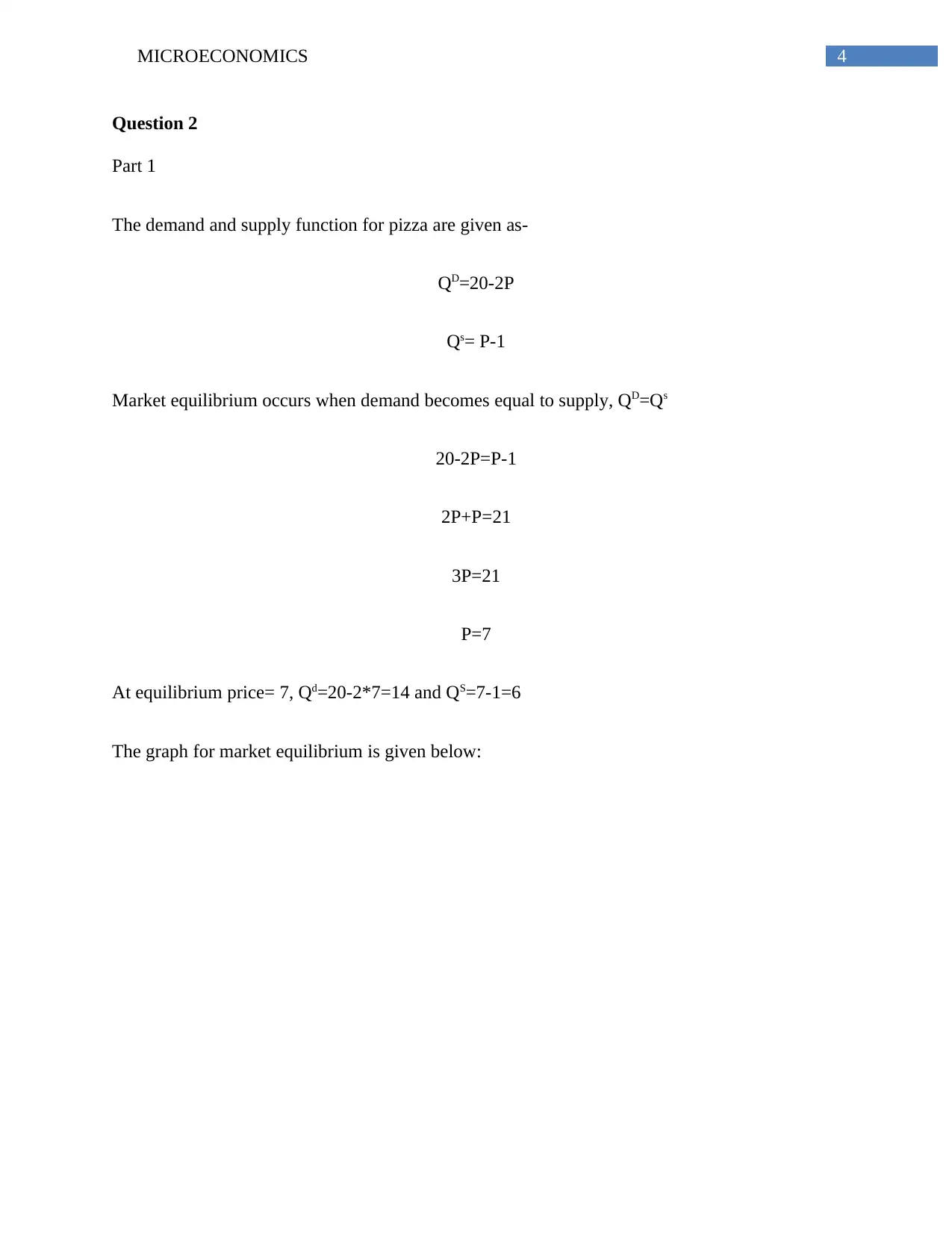
4MICROECONOMICS
Question 2
Part 1
The demand and supply function for pizza are given as-
QD=20-2P
Qs= P-1
Market equilibrium occurs when demand becomes equal to supply, QD=Qs
20-2P=P-1
2P+P=21
3P=21
P=7
At equilibrium price= 7, Qd=20-2*7=14 and QS=7-1=6
The graph for market equilibrium is given below:
Question 2
Part 1
The demand and supply function for pizza are given as-
QD=20-2P
Qs= P-1
Market equilibrium occurs when demand becomes equal to supply, QD=Qs
20-2P=P-1
2P+P=21
3P=21
P=7
At equilibrium price= 7, Qd=20-2*7=14 and QS=7-1=6
The graph for market equilibrium is given below:
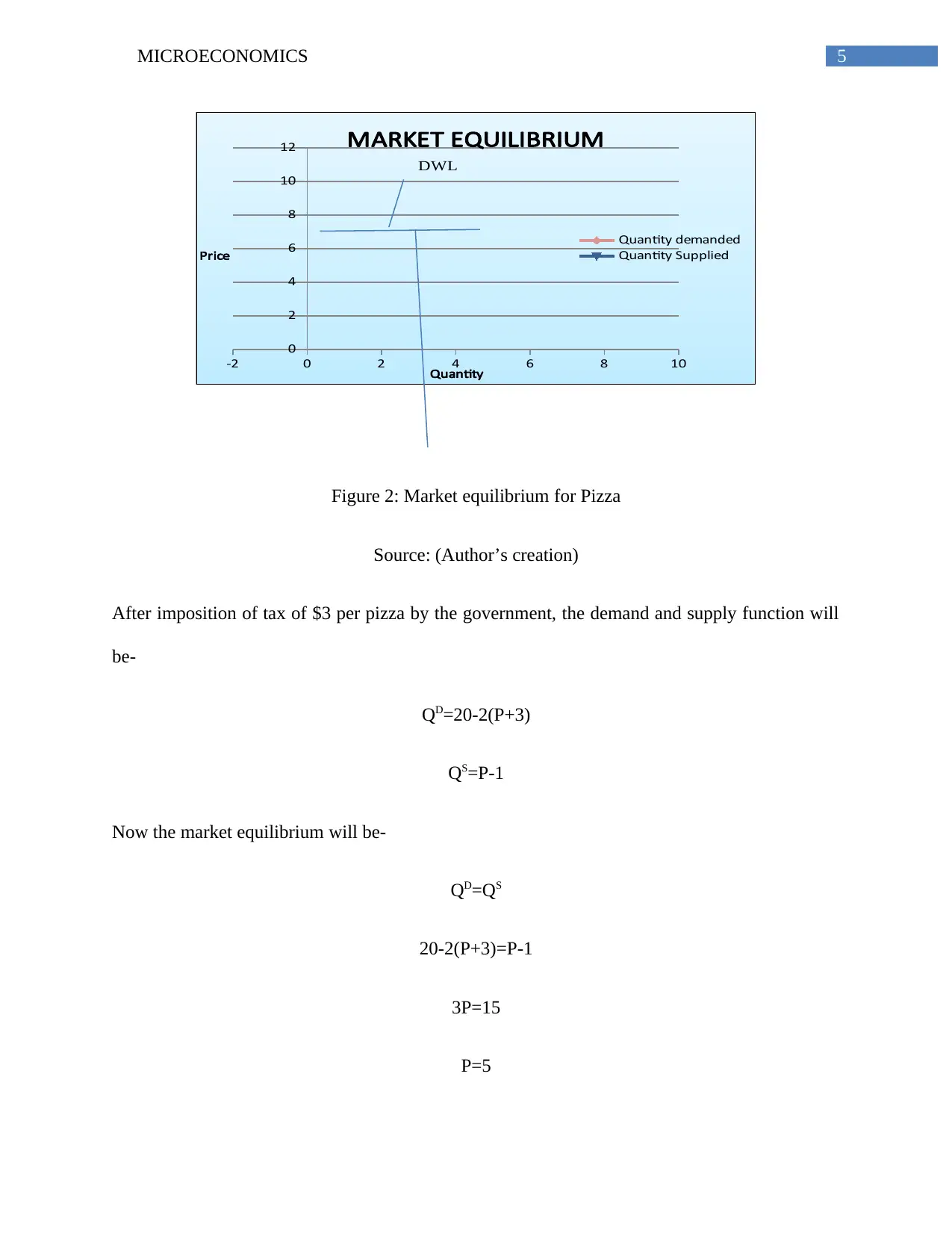
5MICROECONOMICS
-2 0 2 4 6 8 10
0
2
4
6
8
10
12 MARKET EQUILIBRIUM
Quantity demanded
Quantity Supplied
Quantity
Price
DWL
Figure 2: Market equilibrium for Pizza
Source: (Author’s creation)
After imposition of tax of $3 per pizza by the government, the demand and supply function will
be-
QD=20-2(P+3)
QS=P-1
Now the market equilibrium will be-
QD=QS
20-2(P+3)=P-1
3P=15
P=5
-2 0 2 4 6 8 10
0
2
4
6
8
10
12 MARKET EQUILIBRIUM
Quantity demanded
Quantity Supplied
Quantity
Price
DWL
Figure 2: Market equilibrium for Pizza
Source: (Author’s creation)
After imposition of tax of $3 per pizza by the government, the demand and supply function will
be-
QD=20-2(P+3)
QS=P-1
Now the market equilibrium will be-
QD=QS
20-2(P+3)=P-1
3P=15
P=5
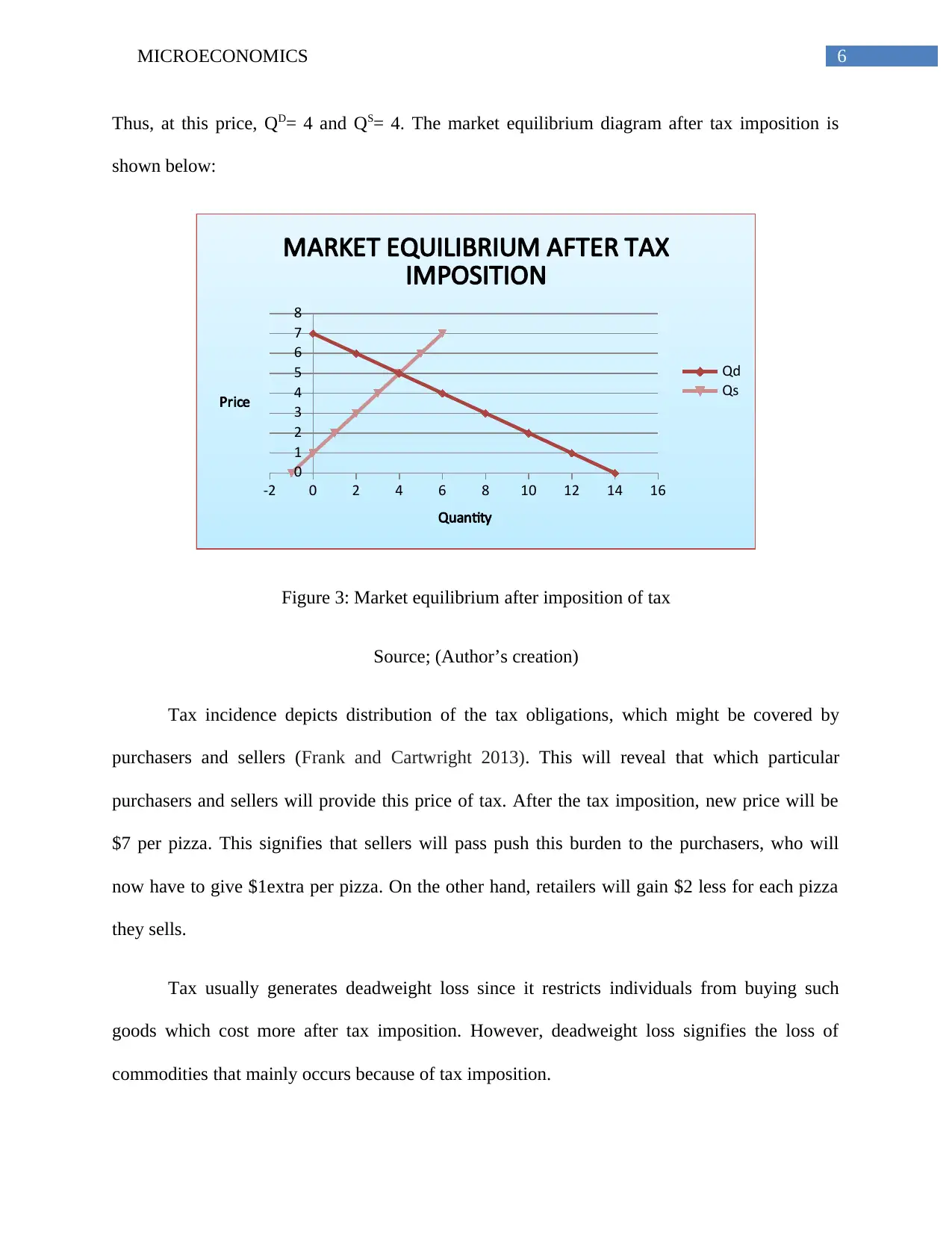
6MICROECONOMICS
Thus, at this price, QD= 4 and QS= 4. The market equilibrium diagram after tax imposition is
shown below:
-2 0 2 4 6 8 10 12 14 16
0
1
2
3
4
5
6
7
8
MARKET EQUILIBRIUM AFTER TAX
IMPOSITION
Qd
Qs
Quantity
Price
Figure 3: Market equilibrium after imposition of tax
Source; (Author’s creation)
Tax incidence depicts distribution of the tax obligations, which might be covered by
purchasers and sellers (Frank and Cartwright 2013). This will reveal that which particular
purchasers and sellers will provide this price of tax. After the tax imposition, new price will be
$7 per pizza. This signifies that sellers will pass push this burden to the purchasers, who will
now have to give $1extra per pizza. On the other hand, retailers will gain $2 less for each pizza
they sells.
Tax usually generates deadweight loss since it restricts individuals from buying such
goods which cost more after tax imposition. However, deadweight loss signifies the loss of
commodities that mainly occurs because of tax imposition.
Thus, at this price, QD= 4 and QS= 4. The market equilibrium diagram after tax imposition is
shown below:
-2 0 2 4 6 8 10 12 14 16
0
1
2
3
4
5
6
7
8
MARKET EQUILIBRIUM AFTER TAX
IMPOSITION
Qd
Qs
Quantity
Price
Figure 3: Market equilibrium after imposition of tax
Source; (Author’s creation)
Tax incidence depicts distribution of the tax obligations, which might be covered by
purchasers and sellers (Frank and Cartwright 2013). This will reveal that which particular
purchasers and sellers will provide this price of tax. After the tax imposition, new price will be
$7 per pizza. This signifies that sellers will pass push this burden to the purchasers, who will
now have to give $1extra per pizza. On the other hand, retailers will gain $2 less for each pizza
they sells.
Tax usually generates deadweight loss since it restricts individuals from buying such
goods which cost more after tax imposition. However, deadweight loss signifies the loss of
commodities that mainly occurs because of tax imposition.
Paraphrase This Document
Need a fresh take? Get an instant paraphrase of this document with our AI Paraphraser
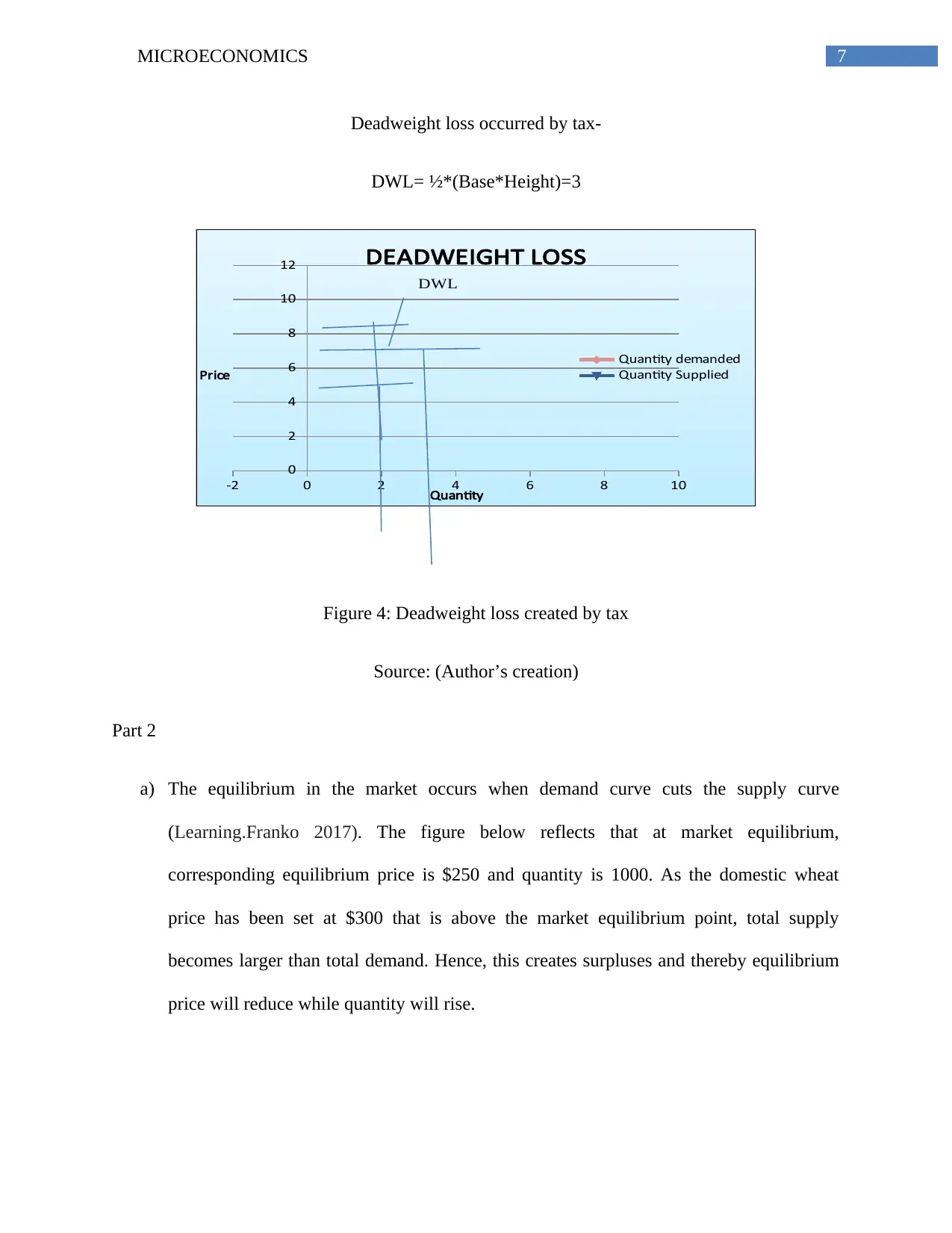
7MICROECONOMICS
Deadweight loss occurred by tax-
DWL= ½*(Base*Height)=3
-2 0 2 4 6 8 10
0
2
4
6
8
10
12 DEADWEIGHT LOSS
Quantity demanded
Quantity Supplied
Quantity
Price
DWL
Figure 4: Deadweight loss created by tax
Source: (Author’s creation)
Part 2
a) The equilibrium in the market occurs when demand curve cuts the supply curve
(Learning.Franko 2017). The figure below reflects that at market equilibrium,
corresponding equilibrium price is $250 and quantity is 1000. As the domestic wheat
price has been set at $300 that is above the market equilibrium point, total supply
becomes larger than total demand. Hence, this creates surpluses and thereby equilibrium
price will reduce while quantity will rise.
Deadweight loss occurred by tax-
DWL= ½*(Base*Height)=3
-2 0 2 4 6 8 10
0
2
4
6
8
10
12 DEADWEIGHT LOSS
Quantity demanded
Quantity Supplied
Quantity
Price
DWL
Figure 4: Deadweight loss created by tax
Source: (Author’s creation)
Part 2
a) The equilibrium in the market occurs when demand curve cuts the supply curve
(Learning.Franko 2017). The figure below reflects that at market equilibrium,
corresponding equilibrium price is $250 and quantity is 1000. As the domestic wheat
price has been set at $300 that is above the market equilibrium point, total supply
becomes larger than total demand. Hence, this creates surpluses and thereby equilibrium
price will reduce while quantity will rise.
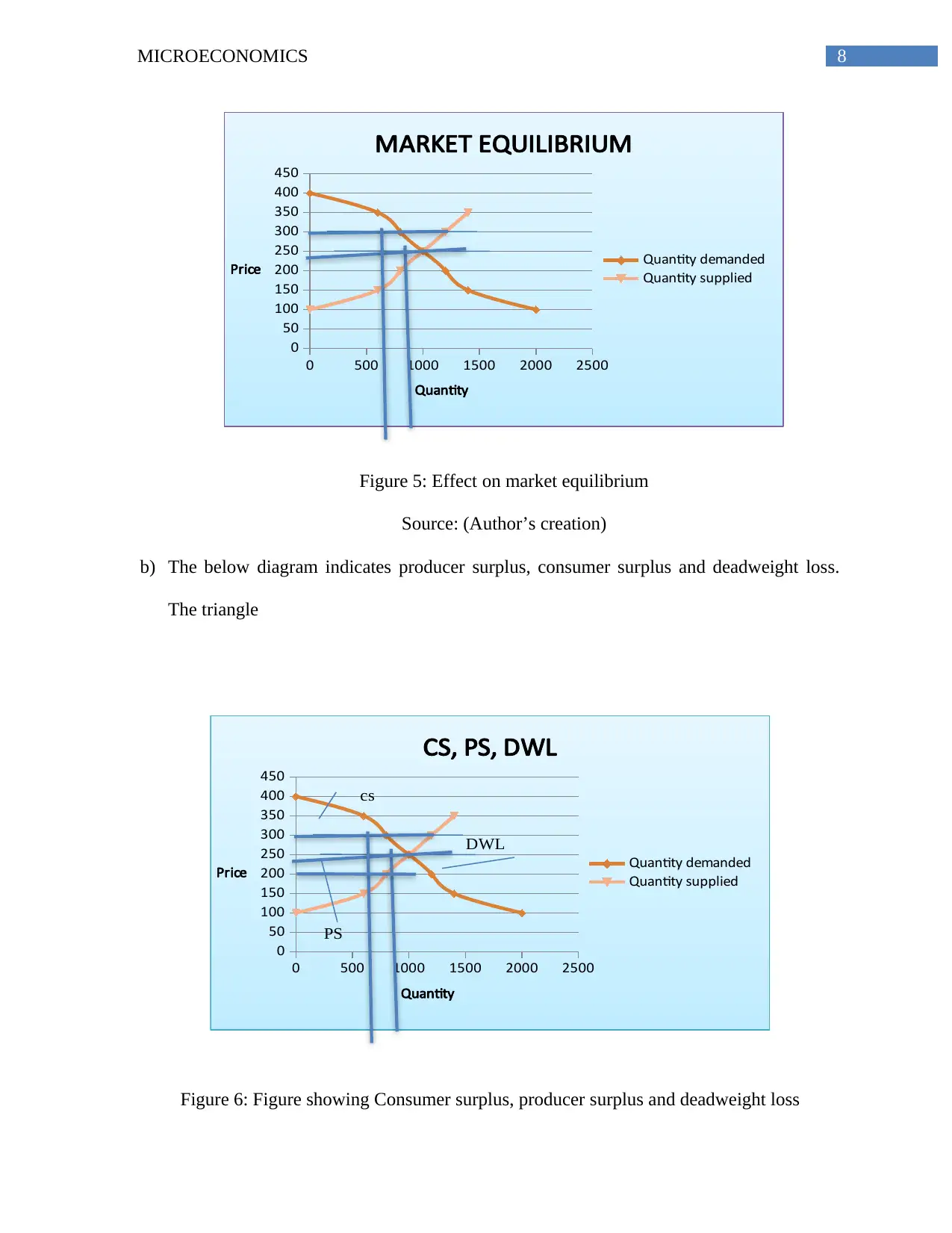
8MICROECONOMICS
0 500 1000 1500 2000 2500
0
50
100
150
200
250
300
350
400
450
MARKET EQUILIBRIUM
Quantity demanded
Quantity supplied
Quantity
Price
Figure 5: Effect on market equilibrium
Source: (Author’s creation)
b) The below diagram indicates producer surplus, consumer surplus and deadweight loss.
The triangle
0 500 1000 1500 2000 2500
0
50
100
150
200
250
300
350
400
450
CS, PS, DWL
Quantity demanded
Quantity supplied
Quantity
Price
cs
PS
DWL
Figure 6: Figure showing Consumer surplus, producer surplus and deadweight loss
0 500 1000 1500 2000 2500
0
50
100
150
200
250
300
350
400
450
MARKET EQUILIBRIUM
Quantity demanded
Quantity supplied
Quantity
Price
Figure 5: Effect on market equilibrium
Source: (Author’s creation)
b) The below diagram indicates producer surplus, consumer surplus and deadweight loss.
The triangle
0 500 1000 1500 2000 2500
0
50
100
150
200
250
300
350
400
450
CS, PS, DWL
Quantity demanded
Quantity supplied
Quantity
Price
cs
PS
DWL
Figure 6: Figure showing Consumer surplus, producer surplus and deadweight loss
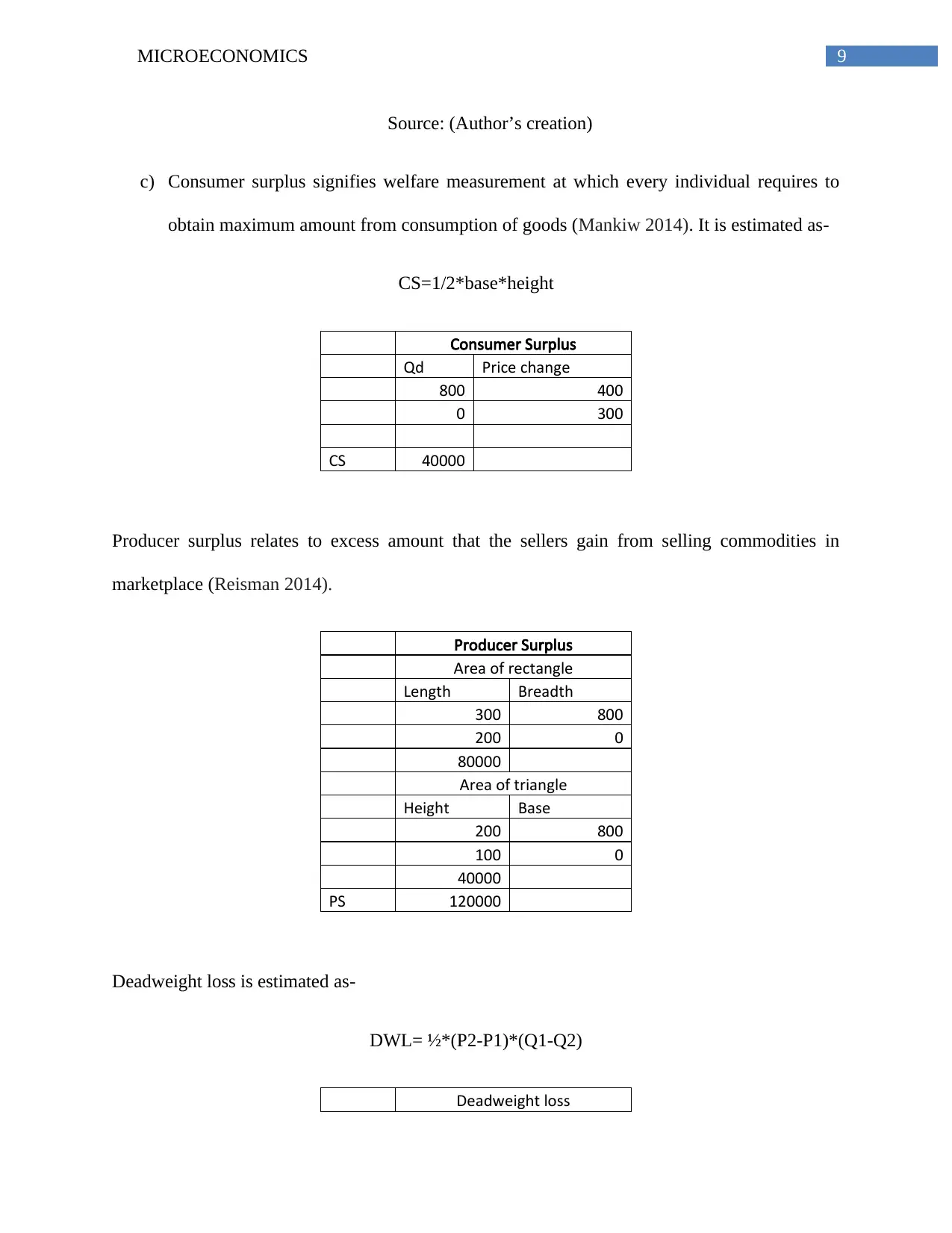
9MICROECONOMICS
Source: (Author’s creation)
c) Consumer surplus signifies welfare measurement at which every individual requires to
obtain maximum amount from consumption of goods (Mankiw 2014). It is estimated as-
CS=1/2*base*height
Consumer Surplus
Qd Price change
800 400
0 300
CS 40000
Producer surplus relates to excess amount that the sellers gain from selling commodities in
marketplace (Reisman 2014).
Producer Surplus
Area of rectangle
Length Breadth
300 800
200 0
80000
Area of triangle
Height Base
200 800
100 0
40000
PS 120000
Deadweight loss is estimated as-
DWL= ½*(P2-P1)*(Q1-Q2)
Deadweight loss
Source: (Author’s creation)
c) Consumer surplus signifies welfare measurement at which every individual requires to
obtain maximum amount from consumption of goods (Mankiw 2014). It is estimated as-
CS=1/2*base*height
Consumer Surplus
Qd Price change
800 400
0 300
CS 40000
Producer surplus relates to excess amount that the sellers gain from selling commodities in
marketplace (Reisman 2014).
Producer Surplus
Area of rectangle
Length Breadth
300 800
200 0
80000
Area of triangle
Height Base
200 800
100 0
40000
PS 120000
Deadweight loss is estimated as-
DWL= ½*(P2-P1)*(Q1-Q2)
Deadweight loss
Secure Best Marks with AI Grader
Need help grading? Try our AI Grader for instant feedback on your assignments.
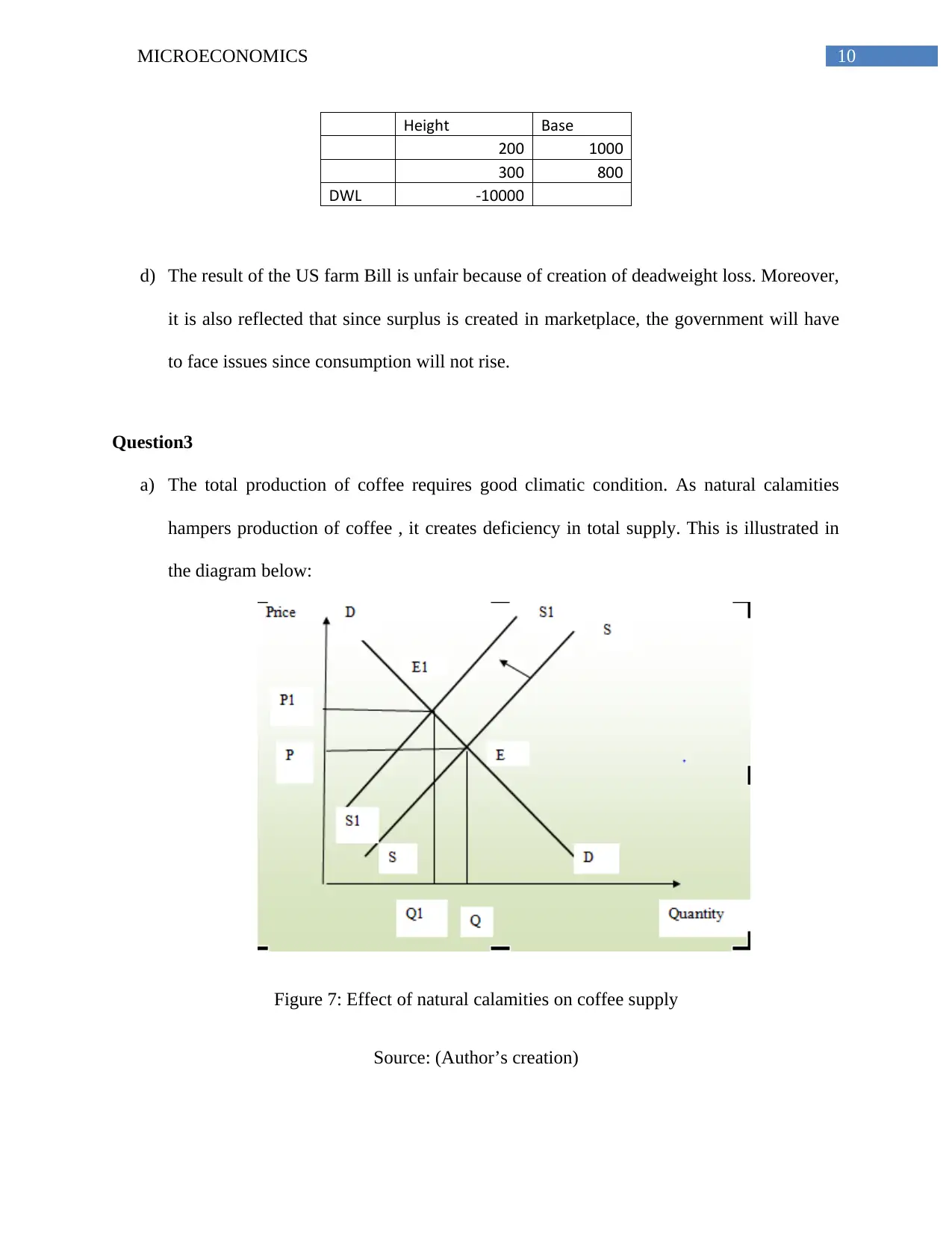
10MICROECONOMICS
Height Base
200 1000
300 800
DWL -10000
d) The result of the US farm Bill is unfair because of creation of deadweight loss. Moreover,
it is also reflected that since surplus is created in marketplace, the government will have
to face issues since consumption will not rise.
Question3
a) The total production of coffee requires good climatic condition. As natural calamities
hampers production of coffee , it creates deficiency in total supply. This is illustrated in
the diagram below:
Figure 7: Effect of natural calamities on coffee supply
Source: (Author’s creation)
Height Base
200 1000
300 800
DWL -10000
d) The result of the US farm Bill is unfair because of creation of deadweight loss. Moreover,
it is also reflected that since surplus is created in marketplace, the government will have
to face issues since consumption will not rise.
Question3
a) The total production of coffee requires good climatic condition. As natural calamities
hampers production of coffee , it creates deficiency in total supply. This is illustrated in
the diagram below:
Figure 7: Effect of natural calamities on coffee supply
Source: (Author’s creation)
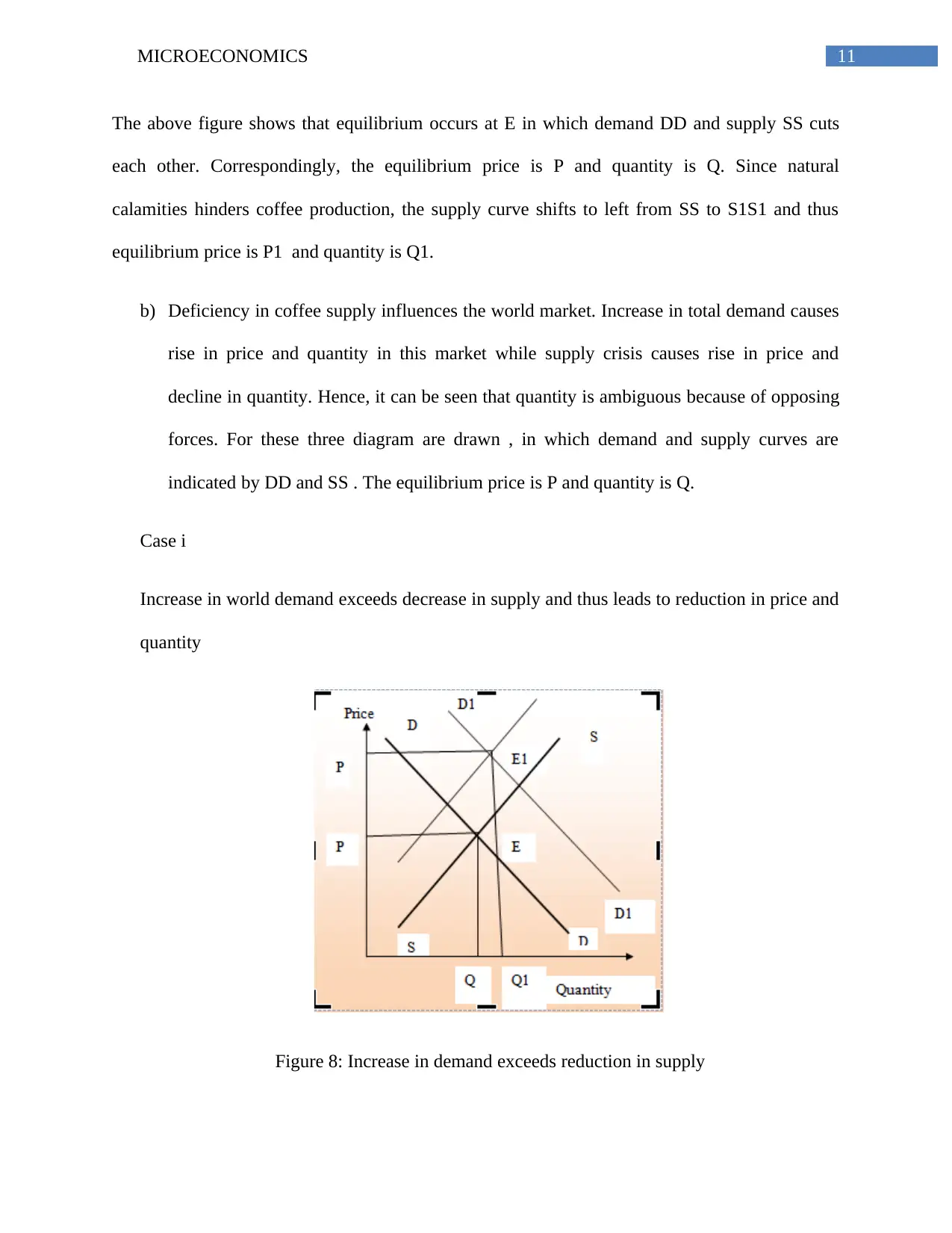
11MICROECONOMICS
The above figure shows that equilibrium occurs at E in which demand DD and supply SS cuts
each other. Correspondingly, the equilibrium price is P and quantity is Q. Since natural
calamities hinders coffee production, the supply curve shifts to left from SS to S1S1 and thus
equilibrium price is P1 and quantity is Q1.
b) Deficiency in coffee supply influences the world market. Increase in total demand causes
rise in price and quantity in this market while supply crisis causes rise in price and
decline in quantity. Hence, it can be seen that quantity is ambiguous because of opposing
forces. For these three diagram are drawn , in which demand and supply curves are
indicated by DD and SS . The equilibrium price is P and quantity is Q.
Case i
Increase in world demand exceeds decrease in supply and thus leads to reduction in price and
quantity
Figure 8: Increase in demand exceeds reduction in supply
The above figure shows that equilibrium occurs at E in which demand DD and supply SS cuts
each other. Correspondingly, the equilibrium price is P and quantity is Q. Since natural
calamities hinders coffee production, the supply curve shifts to left from SS to S1S1 and thus
equilibrium price is P1 and quantity is Q1.
b) Deficiency in coffee supply influences the world market. Increase in total demand causes
rise in price and quantity in this market while supply crisis causes rise in price and
decline in quantity. Hence, it can be seen that quantity is ambiguous because of opposing
forces. For these three diagram are drawn , in which demand and supply curves are
indicated by DD and SS . The equilibrium price is P and quantity is Q.
Case i
Increase in world demand exceeds decrease in supply and thus leads to reduction in price and
quantity
Figure 8: Increase in demand exceeds reduction in supply
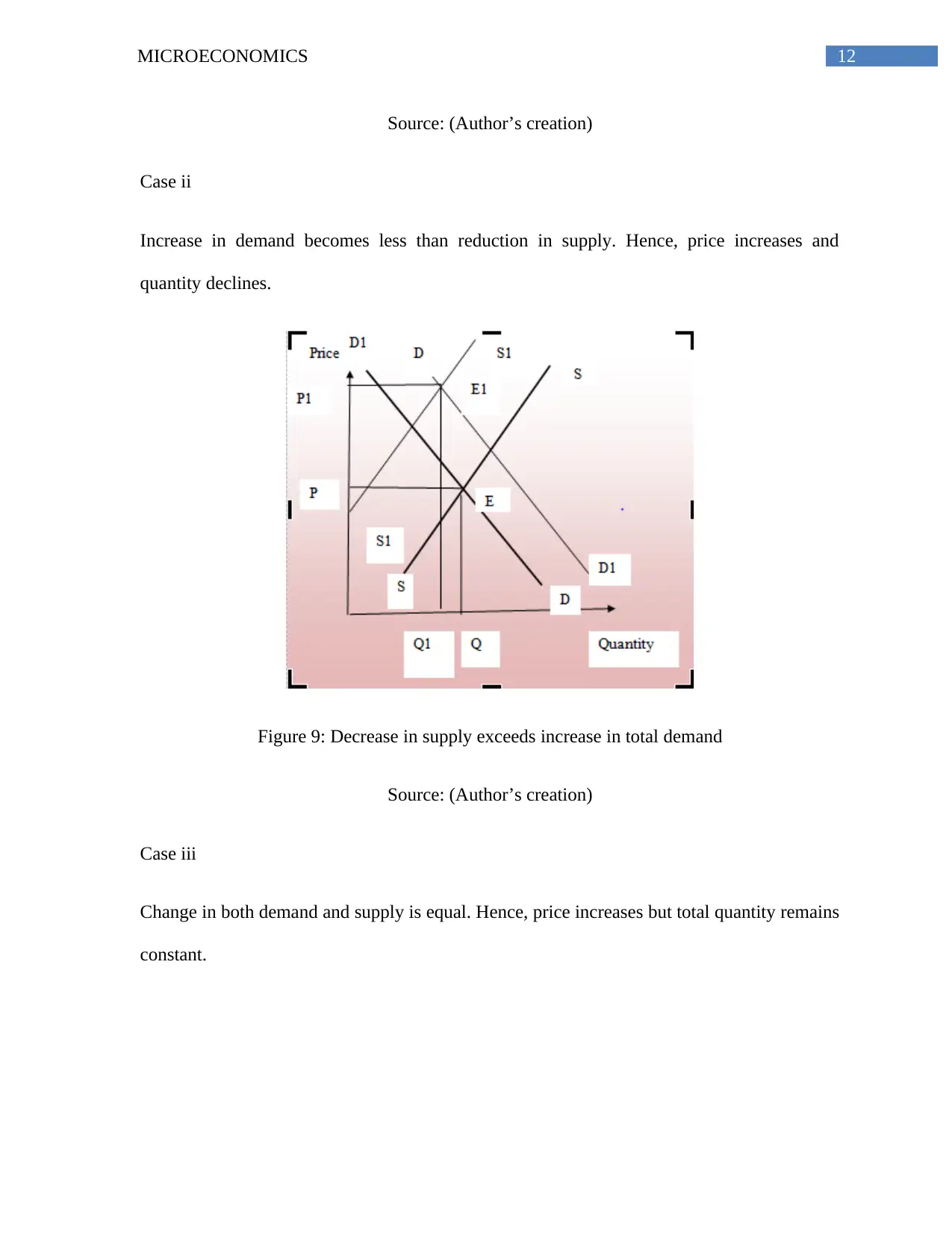
12MICROECONOMICS
Source: (Author’s creation)
Case ii
Increase in demand becomes less than reduction in supply. Hence, price increases and
quantity declines.
Figure 9: Decrease in supply exceeds increase in total demand
Source: (Author’s creation)
Case iii
Change in both demand and supply is equal. Hence, price increases but total quantity remains
constant.
Source: (Author’s creation)
Case ii
Increase in demand becomes less than reduction in supply. Hence, price increases and
quantity declines.
Figure 9: Decrease in supply exceeds increase in total demand
Source: (Author’s creation)
Case iii
Change in both demand and supply is equal. Hence, price increases but total quantity remains
constant.
Paraphrase This Document
Need a fresh take? Get an instant paraphrase of this document with our AI Paraphraser
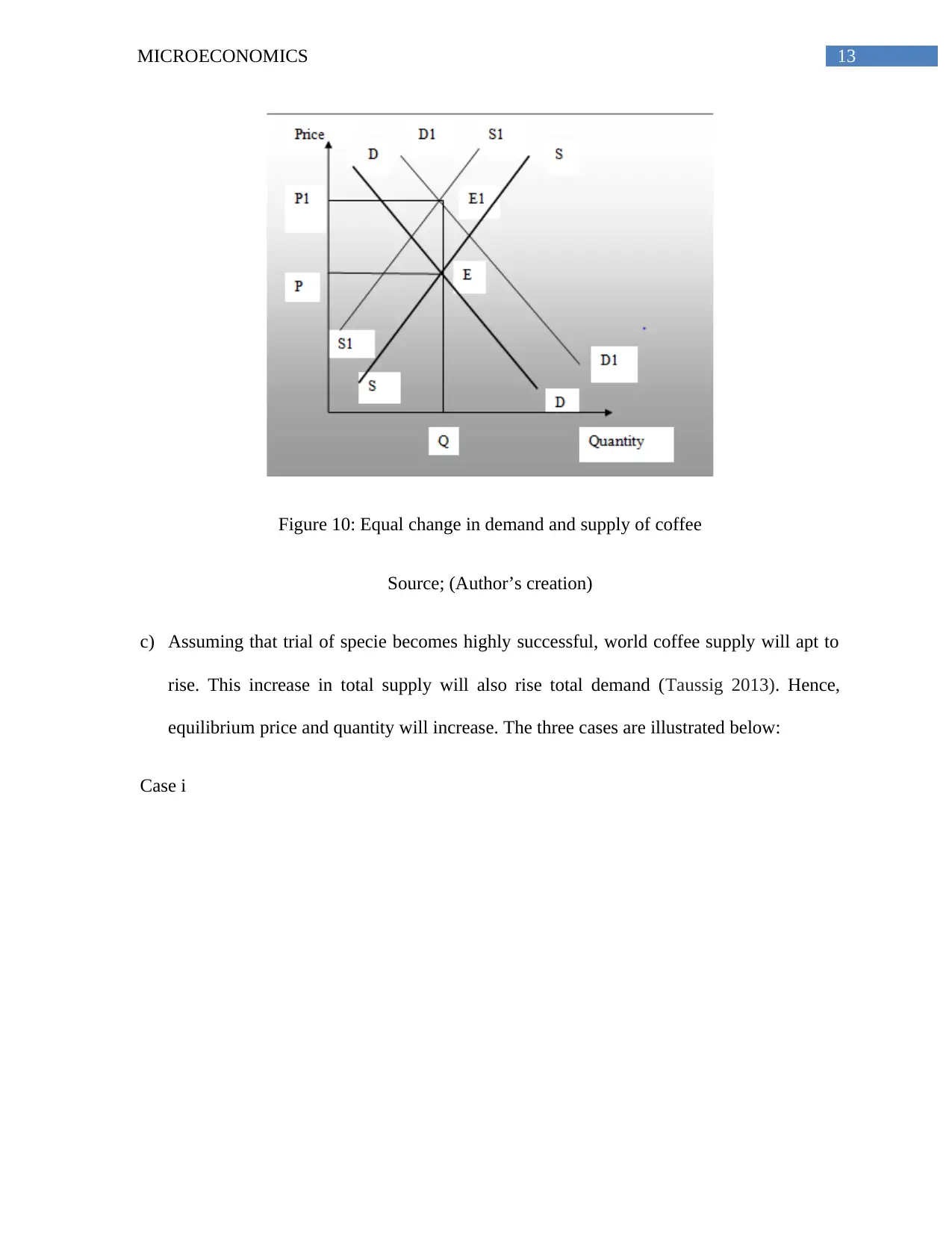
13MICROECONOMICS
Figure 10: Equal change in demand and supply of coffee
Source; (Author’s creation)
c) Assuming that trial of specie becomes highly successful, world coffee supply will apt to
rise. This increase in total supply will also rise total demand (Taussig 2013). Hence,
equilibrium price and quantity will increase. The three cases are illustrated below:
Case i
Figure 10: Equal change in demand and supply of coffee
Source; (Author’s creation)
c) Assuming that trial of specie becomes highly successful, world coffee supply will apt to
rise. This increase in total supply will also rise total demand (Taussig 2013). Hence,
equilibrium price and quantity will increase. The three cases are illustrated below:
Case i
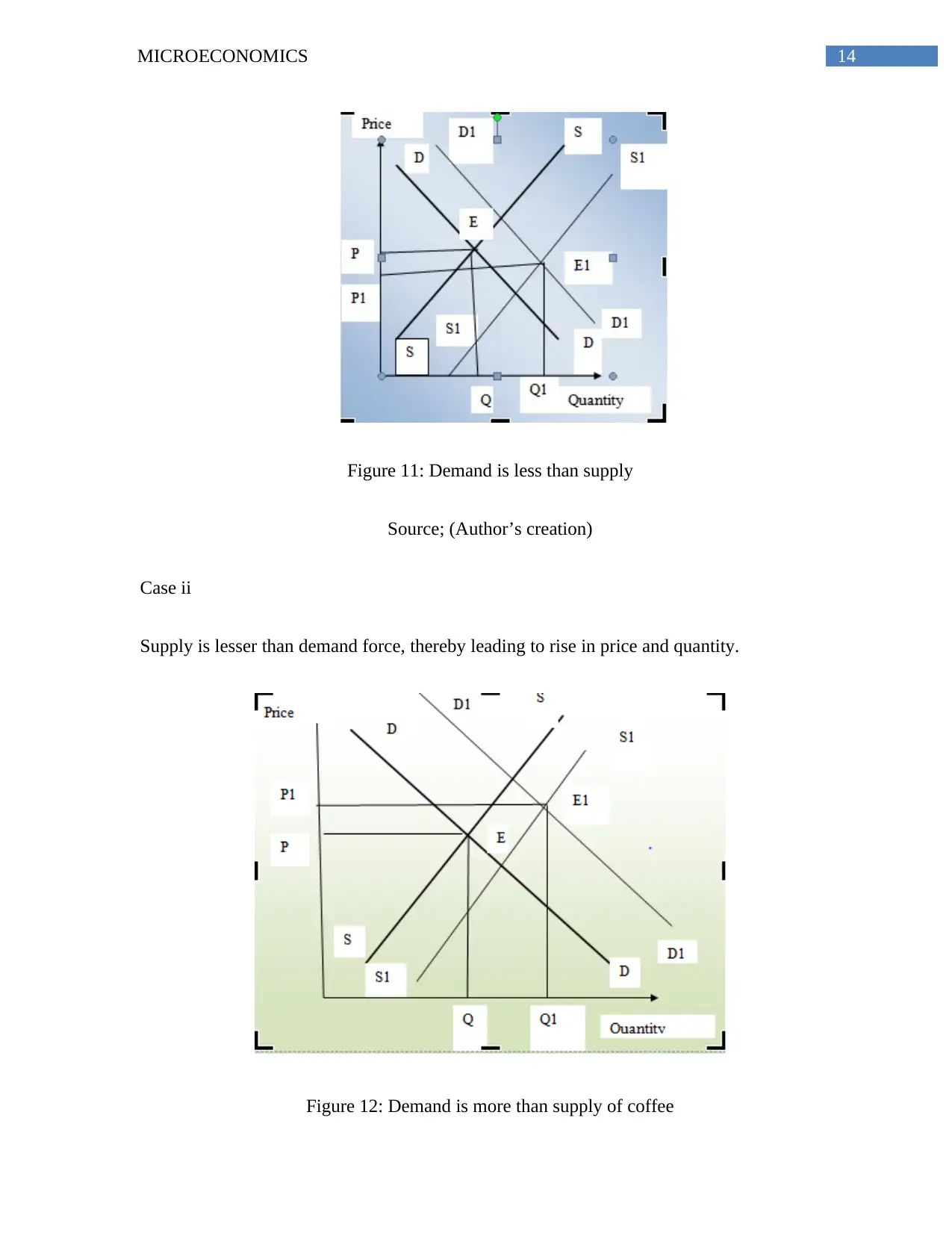
14MICROECONOMICS
Figure 11: Demand is less than supply
Source; (Author’s creation)
Case ii
Supply is lesser than demand force, thereby leading to rise in price and quantity.
Figure 12: Demand is more than supply of coffee
Figure 11: Demand is less than supply
Source; (Author’s creation)
Case ii
Supply is lesser than demand force, thereby leading to rise in price and quantity.
Figure 12: Demand is more than supply of coffee
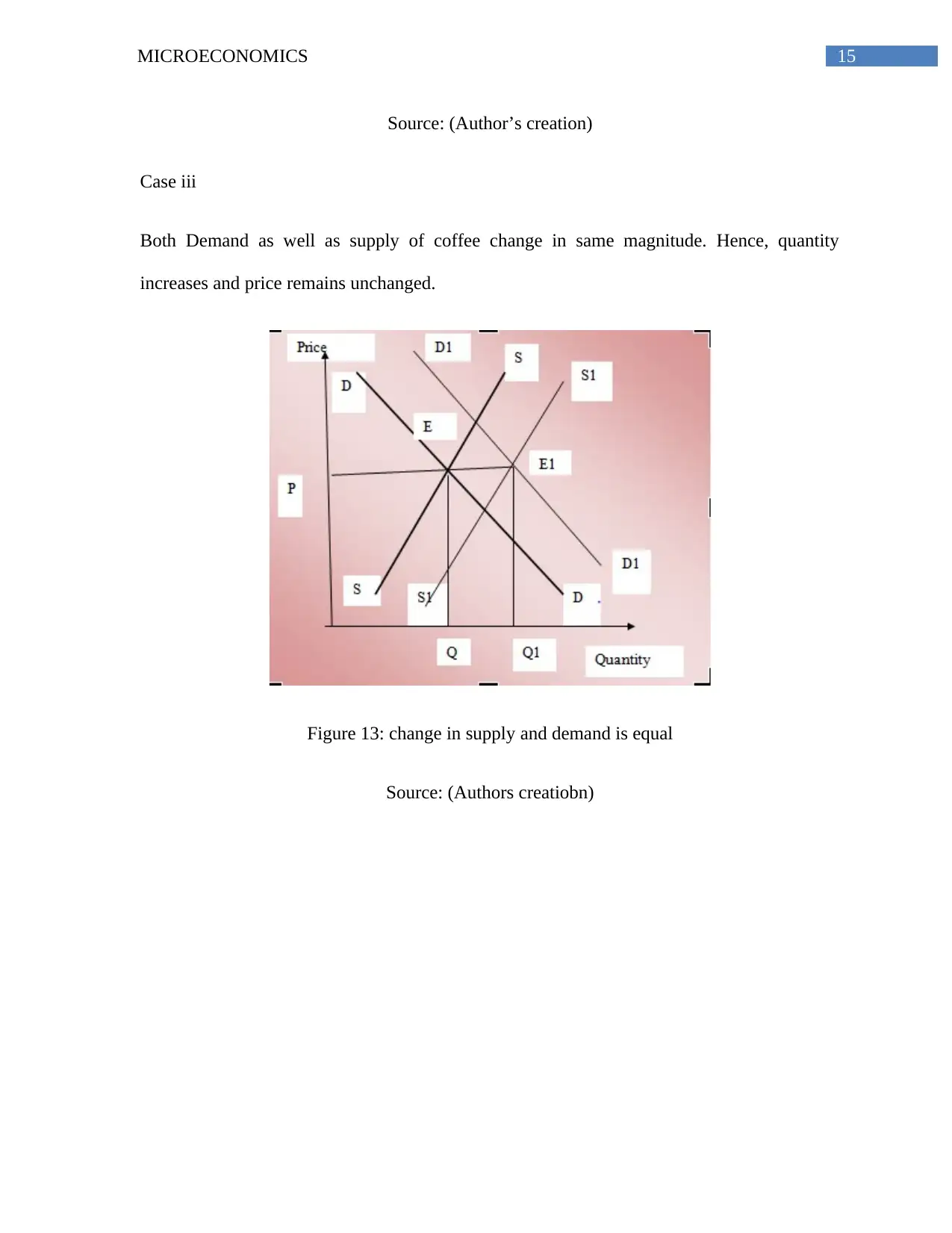
15MICROECONOMICS
Source: (Author’s creation)
Case iii
Both Demand as well as supply of coffee change in same magnitude. Hence, quantity
increases and price remains unchanged.
Figure 13: change in supply and demand is equal
Source: (Authors creatiobn)
Source: (Author’s creation)
Case iii
Both Demand as well as supply of coffee change in same magnitude. Hence, quantity
increases and price remains unchanged.
Figure 13: change in supply and demand is equal
Source: (Authors creatiobn)
Secure Best Marks with AI Grader
Need help grading? Try our AI Grader for instant feedback on your assignments.
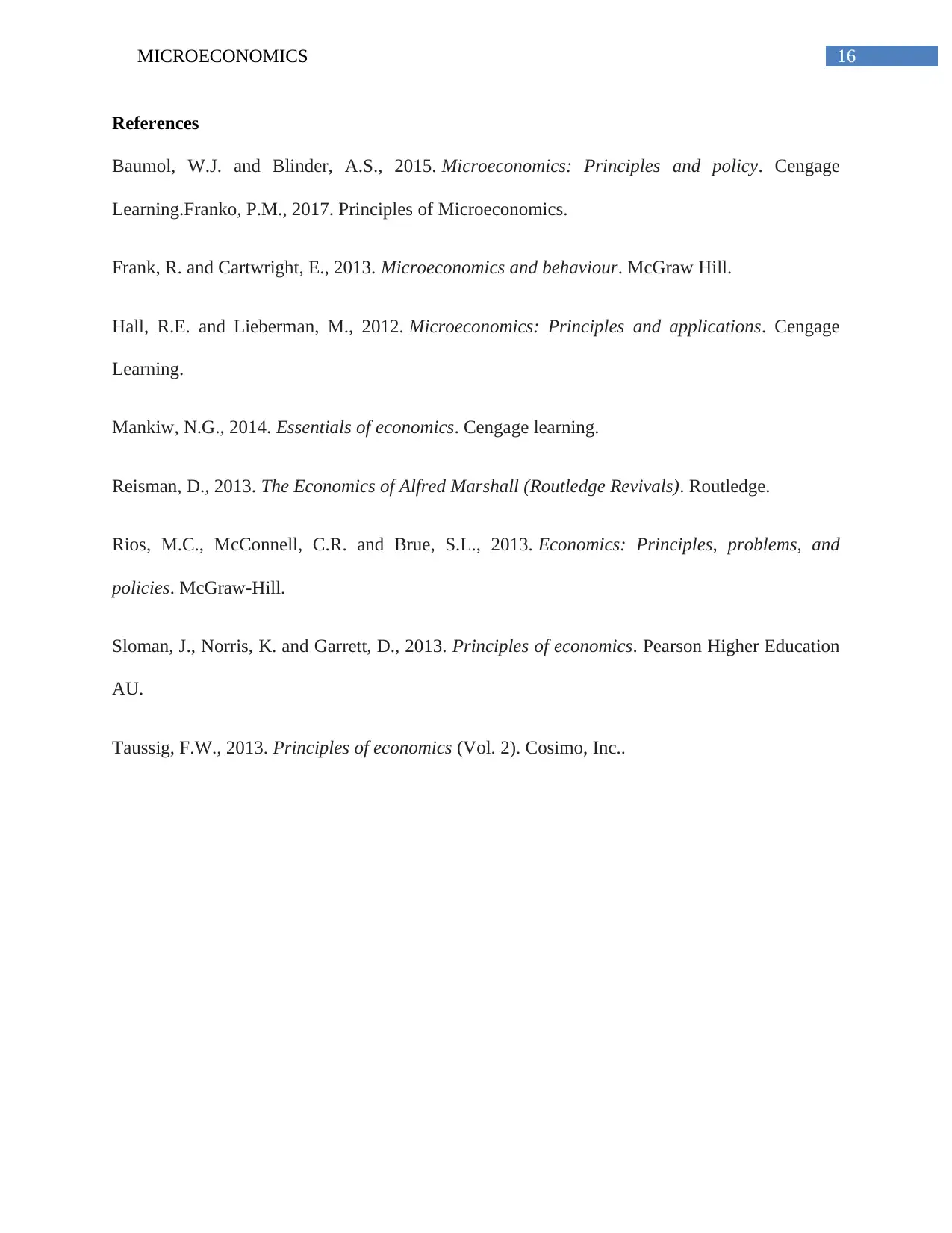
16MICROECONOMICS
References
Baumol, W.J. and Blinder, A.S., 2015. Microeconomics: Principles and policy. Cengage
Learning.Franko, P.M., 2017. Principles of Microeconomics.
Frank, R. and Cartwright, E., 2013. Microeconomics and behaviour. McGraw Hill.
Hall, R.E. and Lieberman, M., 2012. Microeconomics: Principles and applications. Cengage
Learning.
Mankiw, N.G., 2014. Essentials of economics. Cengage learning.
Reisman, D., 2013. The Economics of Alfred Marshall (Routledge Revivals). Routledge.
Rios, M.C., McConnell, C.R. and Brue, S.L., 2013. Economics: Principles, problems, and
policies. McGraw-Hill.
Sloman, J., Norris, K. and Garrett, D., 2013. Principles of economics. Pearson Higher Education
AU.
Taussig, F.W., 2013. Principles of economics (Vol. 2). Cosimo, Inc..
References
Baumol, W.J. and Blinder, A.S., 2015. Microeconomics: Principles and policy. Cengage
Learning.Franko, P.M., 2017. Principles of Microeconomics.
Frank, R. and Cartwright, E., 2013. Microeconomics and behaviour. McGraw Hill.
Hall, R.E. and Lieberman, M., 2012. Microeconomics: Principles and applications. Cengage
Learning.
Mankiw, N.G., 2014. Essentials of economics. Cengage learning.
Reisman, D., 2013. The Economics of Alfred Marshall (Routledge Revivals). Routledge.
Rios, M.C., McConnell, C.R. and Brue, S.L., 2013. Economics: Principles, problems, and
policies. McGraw-Hill.
Sloman, J., Norris, K. and Garrett, D., 2013. Principles of economics. Pearson Higher Education
AU.
Taussig, F.W., 2013. Principles of economics (Vol. 2). Cosimo, Inc..
1 out of 17
Related Documents
Your All-in-One AI-Powered Toolkit for Academic Success.
+13062052269
info@desklib.com
Available 24*7 on WhatsApp / Email
![[object Object]](/_next/static/media/star-bottom.7253800d.svg)
Unlock your academic potential
© 2024 | Zucol Services PVT LTD | All rights reserved.





